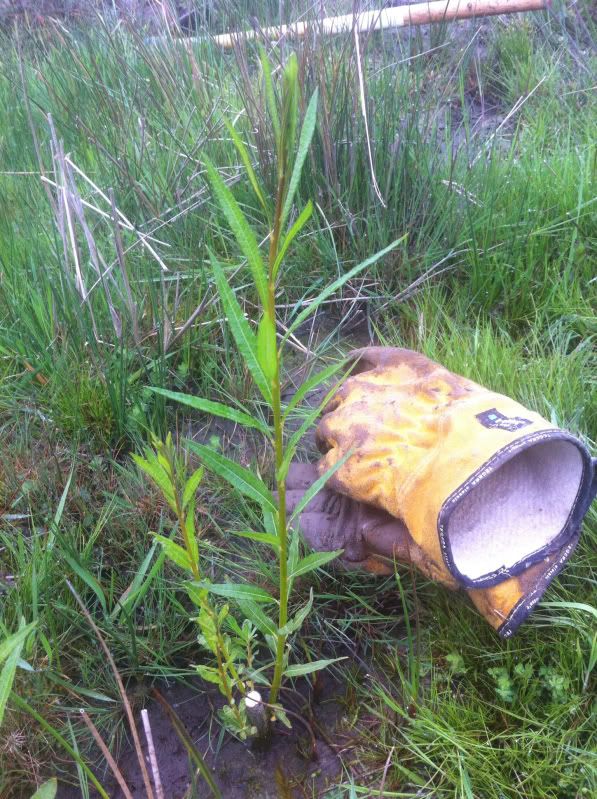Willow gets me excited.
As a lazy man, planting and tending trees was a serious
effort and the speed at which willow grows is amazing, which is why it’s
planted for biomass in many parts of the World. To grow willow could hardly be
simpler. For most species, you buy (or acquire) a stick, called a rod, about
the size of a pencil. As the name suggests, you stick this in the ground and
voila! A willow tree ensues. It’s so potent and ready to root that an infusion
made from bits of willow wood soaked in water will stimulate many other plants
to root, saving money on expensive hormone powders. It’s good for feeding
livestock as well as having multitudinous other uses, such as weaving and
forming living structures.
To give you an idea how rapidly it can grow, in my old
house, there was a willow tree (I think it’s osier viminalis – common osier
– but possibly hybridised with something as I’m sure the leaves were
variegated) planted in the flowerbed next door. It provided too much shade for
the occupants and I was asked if I could trim it in exchange for keeping the
trimmings. Not the best deal in the World, you might say, and you would be
right but I kept on top of it for a couple of years. One year, I was getting
tired of individually sawing through the shoots that were too thick to cut with
secateurs and knowing that it wasn’t a well loved shrub, I too my chainsaw and
cut the thing down to a stump, about as flush to the ground as was possible.
The sad stump sat there for the Winter. We has assumed that it was dead and
weren’t particularly bothered. However, in the Spring, small green shoots
started to appear and by the end of that year, they were up to 3m long and 30mm
in diameter. IN. ONE. YEAR. I’ve taken many of these trimmings and planted them
at our current property where they are doing very well, although as not coming
from a well established stump, I don’t expect they’ll produce the same growth
this year.
 |
| Osier viminalis |
Some economics:
To buy a stick of willow on eBay, for example, costs around
50p. You can find it cheaper but you can pay a lot more.
Now. To encourage willow to produce straight shoots, it
is desirable to plant them close together at, say, 50cm (0.5m) spacings. An
acre is 4,047m2 which, if square, is roughly 63.5m along each side.
Planting a stick at every half metre would give 128 plants along each side, a
total of 16,384. If each of these plants put out 10 shoots (whips) of 2 metres
each, and each shoot was cut into 25cm length that would mean 80 rods per
plant. In one acre, that’s 1,310,720 rods, which at 50p each, is £655,360. Per
acre. Per year. The willow I cut down produced many more shoots that this – I reckon
I planted about 400 rods and had many longer whips left over which I stuck in
the ground for want of something else to do with them. Now, I hear what you
say, selling that amount in would not only be difficult but would also attract
some sort of bulk discount. Let’s say you sold the lot at 10p each. That’s
still £130,000. Obviously, you’d need some sort of harvesting and cutting
equipment in addition to the handling/postage costs but you can see why I asked
my father-in-law, after pointing out we owned 10 acres “What colour helicopter
would you like?”*
* the difficulty being that we’d have nowhere to land them
as all the land would be covered in willow
Regarding biomass, we are accustomed to burning logs in this
country, either on an open fire or in a woodburning stove. With a quick growing
species such as willow, you might get a reasonable sized log in about 4 years,
which then should be dried for a year or so before burning. Why, then, should
one not be able to produce meaningful heat from the smaller shoots that we
could harvest every year? The solution lies in a device known as a rocket
stove, but I have only found one commercially produced version – the Stick Stove,
from Black Mountain Wood Fuels (see links). However, I don’t consider this to
be a very attractive stove and it’s quite a lot of money, but you must admire
the technology. I am working on a similar stove, designed to work inside an old
oil-fired Rayburn that we were given. Hopefully I can be burning my own willow
soon and heating my workshop (unless I can convince my wife to let me put it in
the house).
No comments:
Post a Comment